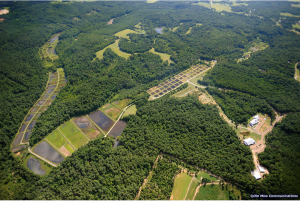Location and Features
The UMFS is located at the headwaters of the Little Tallahatchie River, which drains into the Yazoo River. These waters eventually flow into the Mississippi River, ultimately emptying into the Gulf of Mexico. The facility, with assistance from a knowledgeable and professional staff, supports research, educational, and service programs appropriate to the site. All UMFS programs are high quality sustainable efforts that respect both the participants and the natural environment.
What we have to offer:
The UMFS provides sophisticated indoor and outdoor research and teaching spaces that together comprise a natural laboratory, located 11 miles from the University of Mississippi campus at Oxford, MS. There are more than 740 acres of pine and mixed hardwood forest, bottomland forest, open fields, wetlands (including eight constructed wetlands), ponds and springs. There are also 200 constructed small ponds that allow for experimental manipulation and replication. Scientific questions may be posed related to processes operating at the interface between surface and groundwater systems, and between upland forests and seeps. Diverse disciplines, from academic, governmental and private institutions, are encouraged. Partnerships are developed to address questions relating to hydrological, ecological, chemical, environmental engineering, educational, biological, geological or other related topics.
Research
The primary focus of the UMFS is research. As a research facility, the UMFS serves as a barometer against which spatial and temporal changes can be measured. With data from several similar facilities, information can be combined to characterize regional, national, and/or international trends. The facility collects and stores long-term data for weather, vegetation, water quality and other environmental parameters. The focus is on current University of Mississippi research strengths from a variety of departments and disciplines.
As an important part of a national network of biological field stations, the UMFS supports the six research priorities identified by the National Science Foundation for field stations and marine laboratories nationwide. These are (1) studying the fundamentals of basic biology and ecology, (2) assessing environmental change, (3) maintaining biodiversity, (4) sustaining ecological systems, (5) developing principles for predictive environmental management, and (6) studying environmental restoration and rehabilitation.
Education and Service
As an educational facility, the UMFS allows for “hands-on” field experiences, integrating research with training exercises. This is a facility where graduate, undergraduate, and post-graduate field research can be undertaken. In addition, this is a facility that hosts upper-level undergraduate and graduate level courses on topics that are best presented at the facility.
The UMFS provides a service to the surrounding community by hosting programs for the general public, and by providing facilities for groups with similar missions. A spacious auditorium offers space for hosting research groups and conferences in a peaceful, rustic setting. And as a node within the larger network currently under development by the Organization of Biological Field Stations to collect long-term ecological data throughout North America, the UMFS fosters collaborations with other field stations, and can become an active participant in similar networks.
With beautiful new buildings housing state-of-the-art analytical and computing laboratories, opportunities abound for linking long-term results from monitoring with unbiased compatible datasets obtained at other long-term field locations. Examples of biological monitoring include studying avian migration patterns, analyzing the effects of pollutants on mussels, understanding and tracking invasive species, and assessing types of coliform contamination in water. When combined, these datasets may facilitate regional- to continental-scale assessments.
Center for Water and Wetlands Resources (CWWR)
The UMFS facility provides a physical home for the Center for Water and Wetlands Resources (CWWR). The Center constitutes the largest research program currently residing at the UMFS. In the future there will be additional research centers using UMFS facilities, perhaps equal to or greater than the CWWR in scope and effort. One role of the UMFS is to interpret to the general citizenry the excellent science resulting from research efforts undertaken at the CWWR. The sum of all research and educational programs hosted by the UMFS provides an intellectual community of scholarly endeavor, the synergy of which contributes significantly to the national scientific agenda.
Recognition
The University Administration envisions that in five years the UMFS will be regionally and nationally recognized for the high quality research, education and service programs of the field station that increase scientific understanding of upland watersheds and promote environmental stewardship. The UMFS places great value on sharing information, and will continue to foster collaborations with other researchers and organizations in the collection, analysis and distribution of ecological data.
